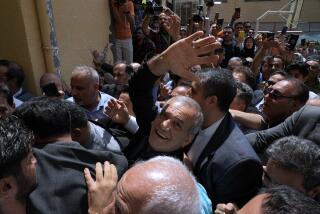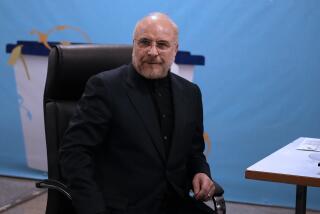Iran’s former President Ahmadinejad relies on tweets to help maintain a public persona

- Share via
TEHRAN — When former Iranian President Mahmoud Ahmadinejad took to Twitter this week to pay tribute to Michael Jackson’s birthday, it didn’t come as a surprise to those who’ve kept up with the hard-line conservative’s presence online.
Since he started using the social media service in 2017, Ahmadinejad has tweeted about a variety of topics, including sports, music, violence and U.S. politics. His tone, which often appears positive and empathetic, contrasts his days as president from 2005 to 2013, during which he denied that the Holocaust happened and was accused of numerous human rights violations.
People affiliated with Ahmadinejad say he runs his account — which has more than 103,000 followers — and that he asks for input only on rare occasions, generally picking whatever topics strike him as most interesting.
But some political observers contend that Ahmadinejad is trying to regain legitimacy after his falling out from Iran’s political scene and that social media exposure is one way of doing so.
“Ahmadinejad’s Twitter account is part of his public diplomacy, especially his English Twitter account. He wants to expose the good and humane aspects of singers, artists, footballers and so on to the world and his fellow countrymen and women,” said Abdulreza Davari, editor in chief of an economic magazine and former advisor during Ahmadinejad’s administration.
He added that Ahmadinejad has a team of technologically savvy computer experts who help him when, on the off occasion, Ahmadinejad runs into technical difficulties.
Other observers and analysts said Ahmadinejad is using Twitter to remain politically relevant, both inside Iran and internationally, despite having been shunned by both conservative and moderate factions within the government.
Ahmadinejad’s political downfall began in 2011 when he refused to support Iran Supreme Leader Ali Khamenei’s reinstatement of the country’s intelligence chief. The former mayor of Tehran, who was once referred to as the protege of Khamenei, found himself enmeshed in a power struggle with the supreme leader and his conservative clerical allies until he left office in 2013.
Since then, those who had rallied in support of Ahmadinejad, namely Khamenei’s conservative allies, came to regret their decision and have marginalized the former president and those who worked in his administration. When he reemerged three years later in an attempt to run for president for a third term, Khamenei told Ahmadinejad that it was “not in the best interests of the country.”
Nader Karimi Juni, an independent analyst based in Tehran and critic of the ex-president, said Ahmadinejad’s behavior on Twitter is an example of how he is trying to improve his reputation domestically and internationally.
“Ahmadinejad himself knows that he and his cronies and close advisors will never be qualified to run for any high-ranking job as long as the current supreme leader is alive or old guards are in power,” Juni said. “He is trying to buy time so that if there’s any leadership change in the future, he and his cronies can come back to power.”
Although Ahmadinejad’s motives for using Twitter may vary, many analysts and activists agree that it has helped the ex-president bypass media censorship in Iran.
“He tweets about what he likes or dislikes in the world of sport, music and art and politics to prove that he himself is not hiding anything from his people,” said Ali Mataji, a media activist based in Tehran and an Ahmadinejad supporter.
Critics say Ahmadinejad’s use of Twitter is ironic given that it was during his presidency in 2009 that Iranian authorities banned Facebook and Twitter, following the brutal crackdown on protesters in demonstrations known as the Green Revolution. Since then, the government has blocked thousands of websites as well as YouTube and the messaging app Telegram and have considered blocking Instagram.
Many Iranians have been able to access those sites by using VPNs, which allows users to mask their web browsing through an unblocked server. Access to those tools, however, has been difficult to come by because of economic sanctions imposed by the U.S.
Ahmadinejad’s tweet Thursday about Jackson, who died in 2009, referenced the song “Man in the Mirror,” reading: “I’m starting with the man in the mirror I’m asking him to change his way” #HB #MJ
Ahmadinejad isn’t the only Iranian politician leveraging the power of social media. Iranian Foreign Minister Mohammad Javad Zarif has a Twitter account as does Iranian President Hassan Rouhani.
To his critics, Ahmadinejad’s efforts to reinvent himself are futile and stand little chance of working, though that does not mean he will stop his attempts to keep from being marginalized.
“That is why he fights for maintaining his social, political and economic status,” Juni said, “so that he is not dropped in oblivion.”
Special correspondent Mostaghim reported from Tehran and Times staff writer Etehad from Los Angeles.
More to Read
Sign up for Essential California
The most important California stories and recommendations in your inbox every morning.
You may occasionally receive promotional content from the Los Angeles Times.











